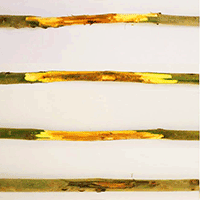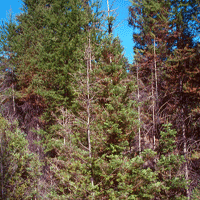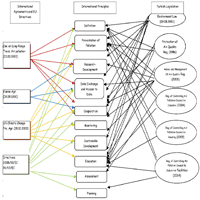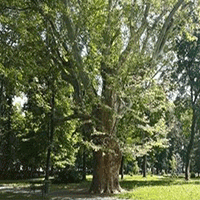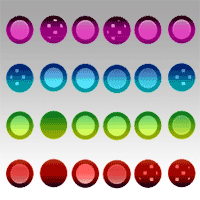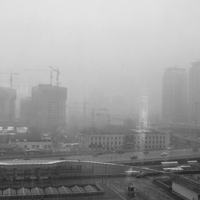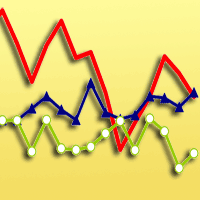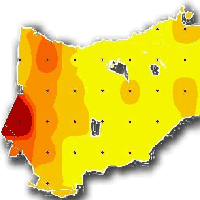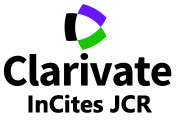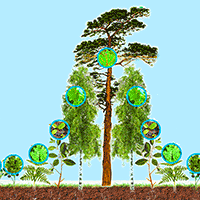
Accumulation of 137Cs and 90Sr radionuclides by dominants and co-dominants of birch-pine forest communities in Northern Ukraine
Oleksandr Lukash (1) , Halina Tkaczenko (2), Oleksandr Yakovenko (1), Anita Szikura (3), Natalia Kurhaluk (2)
iForest - Biogeosciences and Forestry, Volume 17, Issue 6, Pages 386-393 (2024)
doi: https://doi.org/10.3832/ifor4577-017
Published: Dec 20, 2024 - Copyright © 2024 SISEF
Research Articles
Abstract
Investigation of the post-Chernobyl accumulation of radionuclides in forest communities not only sheds light on the specific ecological aftermath of the disaster but also holds broader significance for enhancing our knowledge of radioactive contamination in natural environments and informing strategies for mitigating its impacts. The study was carried out in an area with soil contamination exceeding the pre-accident level for the isotopes cesium (137Cs, 5.0-15.0 Ci km-2) and strontium (90Sr, 0.15-3.0 Ci km-2) in the Semenivka State Forestry (Chernihiv Region, Northern Ukraine). Four experimental plots with an area of 400 m2 each were established in a birch-Scots pine forest, where dominant trees, herb and shrub layers, and mosses were analyzed for radionuclide bioaccumulation. Our results indicate a larger accumulation of 137Cs compared to 90Sr in the forest ecosystem. The highest 137Cs and 90Sr accumulation was detected in the fern Pteridium aquilinum, and the lowest in Pinus sylvestris. Based on our results, we hypothesized that the processes of accumulation and dispersion of 137Cs among the different vegetation layers are more complex compared to 90Sr. MANOVA regression analysis revealed significant differences in the accumulation of radionuclides between different layer levels, plant species and plant parts in the studied forest areas. According β coefficient analysis, both 137Cs and 90Sr are influenced by the site (area type) but in different ways. For 90Sr, the negative β coefficient implies that certain area types are associated with lower Sr accumulation, while for 137Cs the effect of area type may be more complex or context-dependent. These contrasting results suggest that Cs accumulation is more sensitive to changes in layer level compared to Sr. This could be due to differences in the environmental behaviour of these radionuclides, their chemical properties or differences in soil-plant transfer mechanisms. The significant effect of plant species on 137Cs/90Sr accumulation highlights that species-specific characteristics may play a role in radionuclide uptake. Moreover, we found significant differences in 137Cs/90Sr accumulation between different plant parts. Further research on the mechanisms of accumulation and distribution of these radionuclides are essential for better understanding their impact on human health and the environment.
Keywords
Forest Vegetation, Peucedano-Pinetum, Polesie, Radioactive Contamination, Radiocesium (137Cs), Radiostrontium (90Sr)
Authors’ Info
Authors’ address
Oleksandr Yakovenko 0000-0003-1417-6042
Department of Ecology, Geography and Nature Management, T.H. Shevchenko National University “Chernihiv Colehium”, Chernihiv (Ukraine)
Natalia Kurhaluk 0000-0002-4669-1092
Institute of Biology, Pomeranian University in Slupsk, Slupsk (Poland)
Department of Biology and Chemistry, Ferenc Rákóczi II Transcarpathian Hungarian College of Higher Education, Berehove (Ukraine)
Corresponding author
Paper Info
Citation
Lukash O, Tkaczenko H, Yakovenko O, Szikura A, Kurhaluk N (2024). Accumulation of 137Cs and 90Sr radionuclides by dominants and co-dominants of birch-pine forest communities in Northern Ukraine. iForest 17: 386-393. - doi: 10.3832/ifor4577-017
Academic Editor
Rossella Guerrieri
Paper history
Received: Feb 06, 2024
Accepted: Sep 22, 2024
First online: Dec 20, 2024
Publication Date: Dec 31, 2024
Publication Time: 2.97 months
Copyright Information
© SISEF - The Italian Society of Silviculture and Forest Ecology 2024
Open Access
This article is distributed under the terms of the Creative Commons Attribution-Non Commercial 4.0 International (https://creativecommons.org/licenses/by-nc/4.0/), which permits unrestricted use, distribution, and reproduction in any medium, provided you give appropriate credit to the original author(s) and the source, provide a link to the Creative Commons license, and indicate if changes were made.
Web Metrics
Breakdown by View Type
Article Usage
Total Article Views: 5044
(from publication date up to now)
Breakdown by View Type
HTML Page Views: 2877
Abstract Page Views: 1236
PDF Downloads: 802
Citation/Reference Downloads: 0
XML Downloads: 129
Web Metrics
Days since publication: 363
Overall contacts: 5044
Avg. contacts per week: 97.27
Citation Metrics
Article Citations
Article citations are based on data periodically collected from the Clarivate Web of Science web site
(last update: Mar 2025)
Total number of cites (since 2024): 1
Average cites per year: 0.50
Publication Metrics
by Dimensions ©
Articles citing this article
List of the papers citing this article based on CrossRef Cited-by.
References
Radionuclide transfer in forest ecosystems. In: “Quantification of Radionuclide Transfer in Terrestrial and Freshwater Environments for Radiological Assessments”. International Atomic Energy Agency, Vienna, Austria, pp. 333-380.
Gscholar
Scots pine stands biomass assessment using 3D data from unmanned aerial vehicle imagery in the Chernobyl Exclusion Zone. Journal of Environmental Management 295: 113319.
CrossRef | Gscholar
Accumulation of radionuclides by plants as a monitor system. Environmental Health Perspectives 27: 165-179.
Gscholar
Phytocenotic features of Calluna vulgaris (L.) Hill. in Ukrainian Polesie. Ecological Questions 31 (3): 73-107.
Gscholar
Przewodnik do oznaczania zbiorowisk roslinnych Polski [Guide to the determination of Polish plant communities]. Wydawnictwo Naukowe PWN, Warszawa, Poland, pp. 538. [In Polish]
Gscholar
Soil quality. Soil sampling methods for radiation control. SOU 74.14-37-425:2006, Standard of Minagropolitics of Ukraine, Kyiv, Ukraine, pp. 15. [In Ukrainian]
Gscholar
Temporal trends in 137Cs concentrations in the bark, sapwood, heartwood, and whole wood of four tree species in Japanese forests from 2011 to 2016. Journal of Environmental Radioactivity 178- 179: 335-342.
Gscholar
Dose-effect relationships for wildlife and humans in the Chernobyl Exclusion Zone. Journal of Environmental Radioactivity 255: 106947.
Gscholar
Directory for radiological services of Ukraine. Nora-Print, Kyiv, Ukraine, pp. 160. [In Ukrainian]
Gscholar
Geobotany: methodological aspects of research. Lira K, Kyiv, Ukraine, pp. 316. [in Ukrainian]
Gscholar

